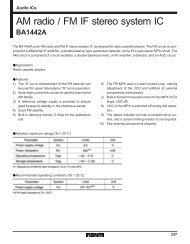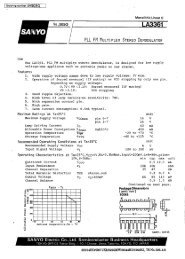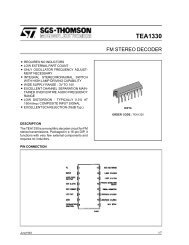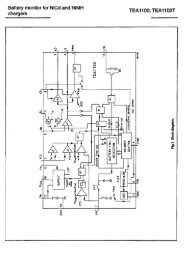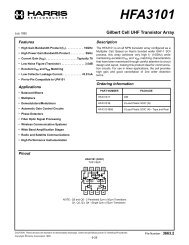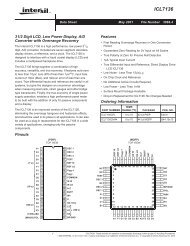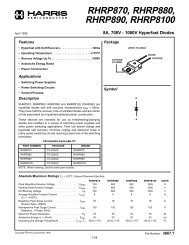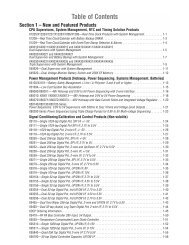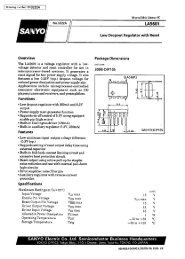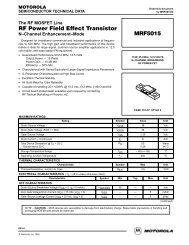ar609 trouble shooting halogen electronic transformers
ar609 trouble shooting halogen electronic transformers
ar609 trouble shooting halogen electronic transformers
You also want an ePaper? Increase the reach of your titles
YUMPU automatically turns print PDFs into web optimized ePapers that Google loves.
Order this document by AR609/D<br />
<br />
<br />
by<br />
Pascal OTERO<br />
Rodrigo BORRAS<br />
MOTOROLA Semiconductors, Toulouse.<br />
<br />
INTRODUCTION<br />
Halogen Electronic Transformers are basic <strong>electronic</strong> step–down converters used to supply 12V to low voltage <strong>halogen</strong><br />
lamps. Based on a high frequency conversion they are less bulky than 50/60Hz <strong>transformers</strong>. In order to achieve a low cost,<br />
<strong>electronic</strong> <strong>transformers</strong> are designed using bipolar transistors instead of MOSFETs. The most common topology used is the<br />
half bridge converter; its basic schematic is shown Figure 1 (see EB407 “Basic Halogen Converter” for a general circuit<br />
description).<br />
LINE<br />
220 V<br />
C4<br />
LINE FILTER<br />
C5<br />
INPUT RECTIFIER<br />
Dz1<br />
Dz2<br />
R1<br />
C1<br />
Q1<br />
D2<br />
330kΩ<br />
1N4937<br />
D1<br />
NODE B<br />
Q2<br />
D3<br />
22nF<br />
1N4937<br />
T1<br />
R3<br />
R2<br />
12V HALOGEN LAMP<br />
Ns<br />
T2<br />
Np<br />
C2<br />
C3<br />
400V<br />
100nF<br />
NODE A<br />
400V<br />
100nF<br />
D4<br />
R4<br />
DIAC 32V<br />
10 Ω<br />
CURRENT LIMIT C<br />
Q3<br />
D5<br />
Q3 = BC546<br />
R7<br />
C8<br />
R6<br />
R5<br />
D5 = 1N4148<br />
R5/R6/R7/C8= to be defined accordingly to<br />
the end application characteristics.<br />
Dz1/Dz2 = 1.5KE200ARL<br />
Figure 1. Basic Schematic Diagram for a 12 V Electronic Transformer<br />
This simple circuit normally sees almost no stress under<br />
nominal operating conditions (as described in EB407) but<br />
because of its particular structure certain phenomena can<br />
cause the bipolar transistors to work very close to their limits.<br />
Designers essentially have to deal with problems related<br />
to<br />
a) voltage spikes on the mains<br />
b) huge inrush currents due either to a cold lamp<br />
start–up or an accidental short circuit<br />
These two points will be discussed in the following pages<br />
and some techniques on how to handle these problems will<br />
be presented.<br />
PREVENTING HIGH VOLTAGE STRESSES<br />
The theoretical VCE rating for the bipolar transistors is the<br />
peak voltage of the rectified mains. In Europe, the mains<br />
typically remain within 185 Vac to 265 Vac with an average<br />
of 230 Vac. Therefore, for 265 Vac the peak DC voltage seen<br />
by the transistors is 375 Vdc.<br />
Taking some safety margin, the BVCEO is chosen<br />
between 400 V and 500 V. But we can observe with the base<br />
drive conditions depicted Figure 1 that the VCE breakdown<br />
voltage of the transistor is no longer the BVCEO (i.e.<br />
base–emitter open) but BVCER instead. Due to the low<br />
impedance connected between base and emitter, the<br />
BVCER is close to 700 V.<br />
MOTOROLA<br />
© Motorola, Inc. 1995<br />
1
If a voltage spike occurs on the mains, this transient is<br />
directly applied across the transistors through the filter.<br />
Figure 2 shows the average occurrence of transients on the<br />
European mains together with their magnitude. The three<br />
curves show variations depending on the user<br />
surroundings: the mains near factories are exposed to<br />
higher transients than the mains near a residential area. Of<br />
course this kind of overvoltage occurs randomly.<br />
VOLTAGE SPIKE (kV)<br />
20<br />
10<br />
5.0<br />
3.0<br />
2.0<br />
1.0<br />
0.5<br />
0.3<br />
0.2<br />
HIGH EXPOSED AREA<br />
MEDIUM EXPOSED AREA<br />
LOW EXPOSED AREA<br />
0.1<br />
0.01 0.1 1.0 10 100 1000<br />
VOLTAGE SPIKE/YEAR<br />
Figure 2. Occurrence of Transients on the Mains<br />
Assuming the transient appears on the peak of the sine<br />
wave, the instantaneous collector voltage can reach 1500 to<br />
2000 V. This means an efficient solution cannot be provided<br />
by a passive bandpass filter. Even with an 8th order filter the<br />
voltage rejection is not high enough to keep the bipolar<br />
transistor within its Safe Operating Area.<br />
Another solution could consist in increasing the<br />
transistor’s BVCES but in that case the die size would need<br />
to be significantly larger in order to guarantee the same<br />
VCE(sat) and the cost would become prohibitive (e.g.<br />
increasing BVCES from 700 V to 1000 V increases the die<br />
size by 30%, all other parameters kept constant). Besides,<br />
this solution would once again set a breakdown voltage limit<br />
that if exceeded would cause the transistor to fail.<br />
Since the higher the voltage spike the shorter the<br />
duration, the best way to prevent transients consists in the<br />
use of transient suppressors. These active devices are<br />
designed to absorb energy voltage transients and are<br />
available in two power handling capabilities: 600 W and<br />
1500 W (for a 1ms surge). We recommend the use of a<br />
1.5KE200A as shown in Figure 1 (Dz1, Dz2).<br />
Transient suppressors are also the only safe way of<br />
protecting transistors against spikes occurring during short<br />
circuit conditions: a high overvoltage combined with a high<br />
collector current will force the transistor out of its FBSOA or<br />
RBSOA into failure.<br />
PREVENTING HIGH CURRENT STRESSES<br />
The nominal collector current is given by<br />
I C P out<br />
<br />
2<br />
V line<br />
(1)<br />
Where IC, Pout and Vline are RMS values and η is the<br />
output transformer efficiency.<br />
The peak collector current depends on the IC wave shape.<br />
Assuming a wave shape factor = √2 the peak collector<br />
current is 0.7 A for 50 W. The collector current depends on<br />
the load impedance. The lamp resistance varies typically<br />
from 0.5 Ω while the lamp is cold to 3 Ω at thermal<br />
equilibrium. Obviously the collector current decreases when<br />
reaching steady state.<br />
TB 50ms<br />
Ic 1A<br />
Figure 3. Start Up Collector Current (50 W<br />
Transformer), the mains being replaced by a DC<br />
power supply VCC = 240 V, Tamb = 23°C.<br />
In fact the main current stress appears during an<br />
accidental short circuit across the load. Under such<br />
conditions the collector current can reach ten times the<br />
nominal current, as is shown in Table 1. The collector current<br />
is limited by wire and contact resistance but also by the<br />
output transformer leakage inductance.<br />
50 W<br />
100 W<br />
Steady state Start–up Short circuit<br />
0.7 A<br />
1.4 A<br />
3.5 A<br />
7.0 A<br />
ÁÁÁ ÁÁÁÁÁ<br />
ÁÁÁÁÁÁ ÁÁÁÁÁ<br />
ÁÁÁÁÁÁÁÁÁÁÁÁÁÁÁÁ<br />
150 W<br />
2.1 A<br />
10.5 A<br />
2<br />
4.5 A<br />
14 A<br />
25 A<br />
Table 1. Collector Current Ratings versus Power<br />
ÁÁÁ<br />
ÁÁÁÁÁÁÁÁÁÁ<br />
ÁÁÁÁÁ<br />
ÁÁÁÁÁÁÁÁÁÁÁÁÁÁÁÁ<br />
The collector current is also limited via the input network<br />
by the VBE, IB and hFE. This high IC level combined with the<br />
high VCE generates high losses or even transistor<br />
desaturation, and the transistor fails by a thermal runaway.<br />
A short circuit protection is added to the converter. This<br />
circuit turns the converter off and needs a time constant to<br />
be triggered. This time constant must be as short as possible<br />
to protect the transistor quickly during a short circuit but must<br />
be long enough to allow the start–up inrush current So<br />
during this time the bipolar transistor must be rugged<br />
enough to sustain the short circuit collector current.<br />
Let us examine the two main ways (that can be combined)<br />
to limit the short circuit current.<br />
1– Keeping the transistor in the saturation area: the<br />
base current is not limited by an external circuit, thus the<br />
VCE(sat) remains low. In this case the collector current is<br />
limited by:<br />
a) Using an inductive load<br />
The inductor sets the collector current slope. The short<br />
circuit period being shorter, the peak collector current is<br />
limited. In some cases this inductor can be the leakage<br />
inductance of the output transformer.<br />
b) Optimizing bridge capacitances<br />
The collector current is supplied by the capacitor bridge<br />
setting the half voltage (node A). The smaller these<br />
ÁÁÁÁÁÁÁÁÁÁÁÁÁÁÁÁ<br />
ÁÁÁÁÁÁÁÁÁÁÁÁÁÁÁÁ<br />
2 MOTOROLA
capacitors are sized the smaller the amount of charges<br />
available to supply the short circuit collector current. On the<br />
other hand the capacitors must be large enough to keep the<br />
node voltage roughly constant. Moreover, one must take<br />
care of the series resonant frequency of the LC network<br />
made by these two capacitors associated in parallel,<br />
connected in series with the output transformer leakage<br />
inductor. These capacitors must be determined to set the<br />
resonant frequency below the operating one. This<br />
frequency increases during short circuit conditions and so<br />
the impedance of the series resonant circuit is higher, the<br />
short circuit current is hence limited.<br />
2– Reducing the base drive<br />
a) Using an emitter negative feedback<br />
As the collector current increases, the voltage across Re<br />
increases as well, reducing the net driving voltage in the<br />
input circuit, so IB and IC decrease.<br />
b) Adjusting the base resistor value<br />
Since the base bias resistor influences both the short<br />
circuit time capability and the overall losses in steady state,<br />
one must make the compromises to get the best behavior<br />
under either a fault condition or a normal operation. Based<br />
on experiments performed on the BUH50 the value of such<br />
a resistor can range between 3.3 Ω to 6.8 Ω (with drive<br />
transformer turns ratio 1/3), but further analysis must be<br />
done if any of the components are changed (power<br />
transistor, drive transformer...).<br />
By reducing the base drive the transistor operates in the<br />
linear mode, and the power dissipation can be tremendous.<br />
The efficiency of this method appears if IB is drastically<br />
attenuated while IC tends to increase, keeping the on state<br />
product: IC x VCE lower than the one achieved without<br />
resistor bias network.<br />
Whatever the jig used, the <strong>halogen</strong> application requires a<br />
transistor having high gain and high current capabilities.<br />
This allows the transistor to be rugged enough to overcome<br />
the high current damaging stress.<br />
The BUH series was specifically designed for these<br />
applications.<br />
The BUH transistors have the best FBSOA and RBSOA<br />
parameters ever designed by MOTOROLA for a given die<br />
size. This technology allows us to fulfill the key parameters<br />
required by the application. Moreover this technology allows<br />
the manufacturing of 200 W converters with power<br />
transistors packaged in the low cost T0220 package,<br />
compared to existing solutions running with bulky T0218 or<br />
T0247 packages.<br />
Figure 4 a) and b) compares the short circuit behaviour<br />
between BUH and standard designs.<br />
The BUH design (4a) recorded at 80 ms shows square<br />
waves and only a slight desaturation: losses remain very<br />
low. The Standard design (4b) recorded at 13 ms (with the<br />
same die size) cannot remain in saturation. A high VCE(on)<br />
combined with high current produces extremely high losses.<br />
This device will fail within a few µs.<br />
3<br />
Vce<br />
100V/div<br />
3<br />
2<br />
Ic<br />
10A/div<br />
2<br />
FIGURE 4a<br />
FIGURE 4b<br />
Figure 4. Short Circuit Conditions in a 150 W Converter with VCC = 240 V.<br />
PRACTICAL POINT OF VIEW<br />
Since the short circuit collector current can be multiplied<br />
by 10 between nominal and short circuit conditions, the<br />
collector current value is highly dependent on the resistive<br />
path seen from the half bridge middle point (node B). This<br />
impedance is made of the winding resistance of the<br />
transformer, connection contacts and lamp to module wire<br />
resistance.<br />
Therefore one must size the winding and the lamp wires<br />
as thin as possible. The limit being of course the Joule<br />
losses allowed.<br />
The thermal aspect of the output transformer is critical: its<br />
core Bsat will decrease by 25% for a temperature rising from<br />
25°C to 100°C. This parameter is often neglected and will<br />
cause unexpected short circuit failures.<br />
For converters with output powers higher than 100 W, the<br />
winding wire resistance decreases and the connection<br />
contact and wires resistance become preponderant.<br />
MOTOROLA<br />
3
CONCLUSION<br />
As discussed, the only safe way to protect a <strong>halogen</strong><br />
converter against overvoltage transients consists in the use<br />
of transient suppressors.<br />
This application requires a high gain and a high current<br />
capability to overcome the huge inrush current under short<br />
circuit conditions.<br />
Motorola specifically developed the BUH series of<br />
transistors to match the <strong>halogen</strong> converter requirements.<br />
Table 2 here below describes the BUH series.<br />
BIBLIOGRAPHY<br />
1. EB407, “Basic Halogen Converter”, Motorola<br />
Engineering Bulletin<br />
2. AN1049, “The <strong>electronic</strong> control of fluorescent lamps.”,<br />
Motorola Application Note<br />
BUH51 BUH50 BUH100 BUH150<br />
ÁÁÁÁÁÁÁÁ<br />
Power ÁÁÁÁ<br />
50 W 50 ÁÁÁ<br />
W WÁÁÁÁ<br />
100 150 W<br />
ÁÁÁÁÁ 3 A ÁÁÁÁ 4 A 10 A ÁÁÁÁÁÁ<br />
15 A<br />
ÁÁÁÁ<br />
Ic continuousÁÁÁÁ<br />
ÁÁÁÁÁ<br />
Ic peak ÁÁÁÁ 8 A ÁÁÁÁ 8 A 20 A ÁÁÁÁÁÁ<br />
25 A<br />
Package<br />
TO220 ÁÁÁ<br />
TO220<br />
ÁÁÁÁÁÁÁÁÁ<br />
ÁÁÁÁÁÁÁÁ<br />
Table 2. BUH Series<br />
TO220ÁÁÁÁ<br />
TO126/C77ÁÁÁÁ<br />
ÁÁÁÁÁÁÁÁÁÁÁÁÁÁÁÁ<br />
ÁÁÁÁÁÁÁÁÁÁÁÁÁÁÁÁ<br />
Motorola reserves the right to make changes without further notice to any products herein. Motorola makes no warranty, representation or guarantee regarding<br />
the suitability of its products for any particular purpose, nor does Motorola assume any liability arising out of the application or use of any product or circuit,<br />
and specifically disclaims any and all liability, including without limitation consequential or incidental damages. “Typical” parameters can and do vary in different<br />
applications. All operating parameters, including “Typicals” must be validated for each customer application by customer’s technical experts. Motorola does<br />
not convey any license under its patent rights nor the rights of others. Motorola products are not designed, intended, or authorized for use as components in<br />
systems intended for surgical implant into the body, or other applications intended to support or sustain life, or for any other application in which the failure of<br />
the Motorola product could create a situation where personal injury or death may occur. Should Buyer purchase or use Motorola products for any such<br />
unintended or unauthorized application, Buyer shall indemnify and hold Motorola and its officers, employees, subsidiaries, affiliates, and distributors harmless<br />
against all claims, costs, damages, and expenses, and reasonable attorney fees arising out of, directly or indirectly, any claim of personal injury or death<br />
associated with such unintended or unauthorized use, even if such claim alleges that Motorola was negligent regarding the design or manufacture of the part.<br />
Motorola and are registered trademarks of Motorola, Inc. Motorola, Inc. is an Equal Opportunity/Affirmative Action Employer.<br />
How to reach us:<br />
USA / EUROPE: Motorola Literature Distribution;<br />
JAPAN: Nippon Motorola Ltd.; Tatsumi–SPD–JLDC, Toshikatsu Otsuki,<br />
P.O. Box 20912; Phoenix, Arizona 85036. 1–800–441–2447 6F Seibu–Butsuryu–Center, 3–14–2 Tatsumi Koto–Ku, Tokyo 135, Japan. 03–3521–8315<br />
MFAX: RMFAX0@email.sps.mot.com – TOUCHTONE (602) 244–6609 HONG KONG: Motorola Semiconductors H.K. Ltd.; 8B Tai Ping Industrial Park,<br />
INTERNET: http://Design–NET.com 51 Ting Kok Road, Tai Po, N.T., Hong Kong. 852–26629298<br />
4 ◊<br />
MOTOROLA AR609/D



